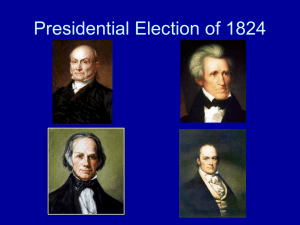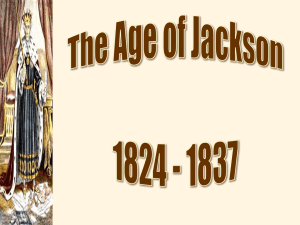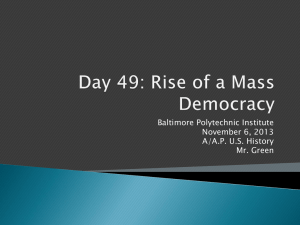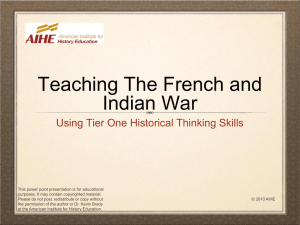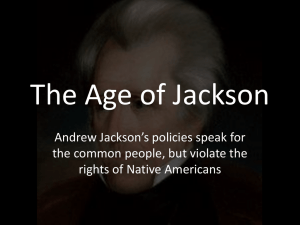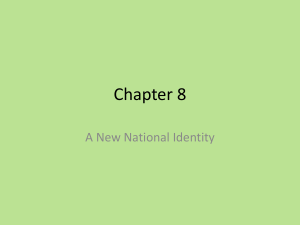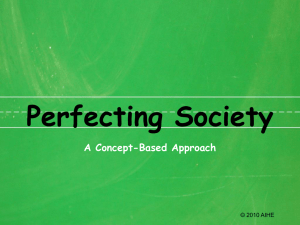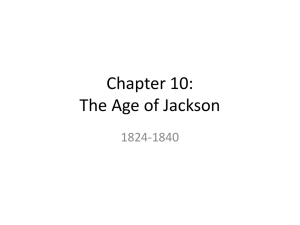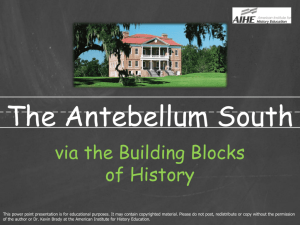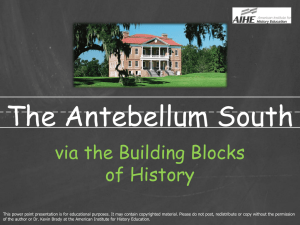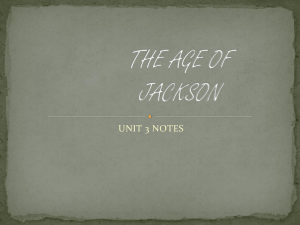Teaching The French and Indian War - Gallia
advertisement
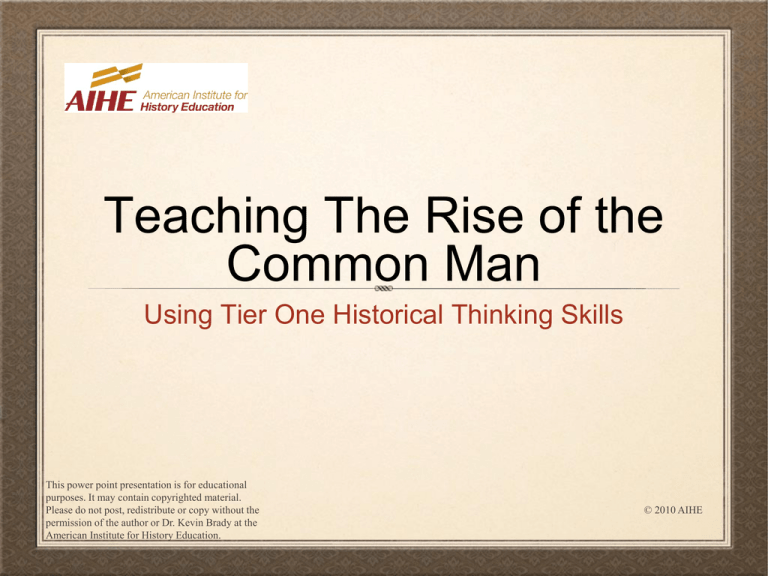
Teaching The Rise of the Common Man Using Tier One Historical Thinking Skills This power point presentation is for educational purposes. It may contain copyrighted material. Please do not post, redistribute or copy without the permission of the author or Dr. Kevin Brady at the American Institute for History Education. © 2010 AIHE Goal(s) & Sequence To demonstrate a way to teach the era of the common man through the use of multiple sources, visuals, timelines, and practicing critical thinking. 1. 2. 3. 4. 5. 6. 7. 8. Begin with classic narrative history Discuss the scope and sequence of the era Examine geographic changes Condense into bullet-points Analyze electoral results Use of period political cartoons Boil information down into bare essentials Corroborate © 2010 AIHE Directions • This is an interactive presentation i.e. you should pay attention and interact with me • You need to read any information on each slide and formulate answers to any questions that appear on the slide • Look for ways that you could use similar techniques in your own classroom © 2010 AIHE Where does this piece fit? © 2010 AIHE Seeing the Greater View of History Determining the main idea of a selection or work of history Establishing time, scope, and sequence in which the events of an era take place Eliminating things that are not essential to focus on essential understandings © 2010 AIHE Building a Personal and Intimate Connection to the Past Seeking personal or local connections to history whenever possible Seeing history as the story of people and their voice rather than dry and disconnected events © 2010 AIHE Avoiding the lure of Historical Presentism Establishing the values and beliefs of the time as a lens to analyze the past Using the values of the time to analyze historical meaning rather than those from the 21st century Compare and contrast the values of the past with those of the present © 2010 AIHE Analyzing and Utilizing Multiple Historical Sources Analysis of primary sources to study history “in the raw” Determination of bias and unique point of view of historical sources Establishing and assessing the reliability of historical sources Utilizing primary and secondary sources as companion material to the textbook © 2010 AIHE Let’s go do it! © 2010 AIHE The Rise of the Common Man and changes in American political involvement Change is Afoot In 1821, American politics was still largely dominated by deference. Competing political parties were nonexistent and voters generally deferred to the leadership of local elites or leading families. Political campaigns tended to be relatively staid affairs. Direct appeals by candidates for support were considered in poor taste. Election procedures were, by later standards, quite undemocratic. Most states imposed property and taxpaying requirements on the white adult males who alone had the vote, and they conducted voting by voice. Presidential electors were generally chosen by state legislatures. Given the fact that citizens had only the most indirect say in the election of the president, it is not surprising that voting participation was generally extremely low, amounting to less than 30 percent of adult white males. Determining the Main Idea From www.digitalhistory.uh.edu – Jacksonian Democracy © 2010 AIHE Between 1820 and 1840, a revolution took place in American politics. In most states, property qualifications for voting and office holding were repealed; and voting by voice was largely eliminated. Direct methods of selecting presidential electors, county officials, state judges, and governors replaced indirect methods. Because of these and other political innovations, voter participation skyrocketed. By 1840 voting participation had reached unprecedented levels. Nearly 80 percent of adult white males went to the polls. Determining the Main Idea From www.digitalhistory.uh.edu – Jacksonian Democracy © 2010 AIHE A new two-party system, made possible by an expanded electorate, replaced the politics of deference to and leadership by elites. By the mid-1830s, two national political parties with marked philosophical differences, strong organizations, and wide popular appeal competed in virtually every state. Professional party managers used partisan newspapers, speeches, parades, rallies, and barbecues to mobilize popular support. Our modern political system had been born. Determining the Main Idea © 2010 AIHE From www.digitalhistory.uh.edu – Jacksonian Democracy Establishing time, scope, and sequence 1801 1820 1814 1825 1836 1828 1824 1829 Jackson wins election of 1828 Suffrage expands to include all white men Thomas Jefferson becomes 3rd President Treaty of Ghent ends the War of 1812 Election of 1824 Jackson leaves office after two terms Jackson’s inauguration The “corrupt bargain” © 2010 AIHE Causes of the “New Democracy” © 2010 AIHE Pressures on the One-Party System Two Big Causes of Pressure •New England Industrializes •Cotton cultivation explodes in the south Party Identification Areas of the nation increasingly identified with the “old guard” parties • Northeast – Federalists •Belief in a strong central government • South – Jeffersonians •Suspicious of government’s powers America 1783 Use of multiple sources America 1802 Use of multiple sources America 1820 Use of multiple sources Expansion of Voting Rights •The most significant political innovation of the early nineteenth century was the abolition of property qualifications for voting and office holding. •Hard times resulting from the panic of 1819 led many people to demand an end to property restrictions on voting and office holding. •By 1840, universal white manhood suffrage had largely become a reality. Only three states--Louisiana, Rhode Island, and Virginia--still restricted the suffrage to white male property owners and taxpayers. Determining the Main Idea From www.digitalhistory.uh.edu – Jacksonian Democracy © 2010 AIHE Encouraging People to Vote •In order to encourage popular participation in politics, most states also instituted statewide nominating conventions, opened polling places in more convenient locations, extended the hours that polls were open, and eliminated the earlier practice of voting by voice. •Each party had a different colored ballot, which voters deposited in a publicly viewed ballot box, so that those present knew who had voted for which party. Determining the Main Idea From www.digitalhistory.uh.edu – Jacksonian Democracy © 2010 AIHE Who Could Vote? Voting Eligibility Most States • Generally all adult white men (by 1840 anyhow) • Immigrant males who claimed to intend to become citizens Some States • Women • Only NJ and had to be unmarried and own property • Free blacks • New Hampshire, Maine, Massachusetts, Vermont only What Does this Mean? • A New Democratic Idea of Politics • Politics MUST express the will of the common man • (Politicians now had to cater to the masses) a man for the people • Campaigning • BBQ’s – free food and alcohol to woo the voters Election of 1824 The Rise of Sectional Candidates • John Quincy Adams – North • Henry Clay – West • John Crawford – South • Andrew Jackson – Wild Card, combination of South and West The Jacksonian Appeal From his “Memorandums” written in the early 1820’s • Believed that the National Bank and the national debt were corrupting influences • Believed that the government had become corrupt and was snuffing out liberty • Thought that a virtuous citizenry could fix the problems • Felt that the government should be subject to the will of the people Who Won? Popular Vote Electoral Vote House Vote J Q Adams 113,142 84 13 Andrew Jackson 151,363 99 7 William Crawford 41,032 41 4 Henry Clay 47,545 37 0 On the left, candidates John Quincy Adams, William Crawford, and Andrew Jackson (left to right) sprint for the finish line. On the right, the fourth candidate Henry Clay has pulled up short and stands, hand on head, exclaiming, ‘D--n it I cant save my distance – so I may as well draw up.’ A supporter, in riding clothes, consoles him, ‘Well dont distress yourself – there’ll be some scrubbing by & by & then you’ll have a chance.’ Use of multiple sources Using the values of the time A Corrupt Bargain? "Well it comes to the same thing," said Mr. Lowry, "it was Clay after all, for Scott was a mere emissary of his, and had previously by his arts secured the votes of this one too. Scott was irresolute, until Clay got hold of him, he had him with him until late last night. And altho his inclination led him to vote for us, Clay had power to persuade him to vote for Adams. 'Ah,' as John Randolph observed after counting the ballots, 'it was impossible to win the game, gentlemen, the cards were stacked.'" "And that," said Mr. Cobb, nodding his head, "is fact and the people have been tricked out of the man of their choice." Story of People and their Voice From the writings of Margaret Bayard Smith © 2010 AIHE A Corrupt Bargain? (part 2) In early January 1824 John Quincy Adams invited Henry Clay to visit him at his residence and the two men spoke for several hours. It is unknown whether they reached some sort of deal, but suspicions were widespread. On February 9, 1825, the House of Representatives held its election, in which each state delegation would get one vote. Henry Clay had made it known that he was supporting Adams, and thanks to his influence, Adams won the vote and was thus elected president. Determining the Main Idea © 2010 AIHE A Corrupt Bargain? (part 3) From the beginning, Clay had decided to support Adams. Clay was fearful of what would happen if Jackson took office because of his strong military background. Although he and his supporters were aware that a vote for Adams would mean advancement for Clay's career, he claims to have voted solely for the good of the people. Harry L. Watson claims that "Despite differences in their personal styles, Clay easily realized that he and Adams shred similar goals for the country, while he saw little of value in the policies of Jackson and Crawford. Crawford, moreover, lay deathly ill and could not perform the duties of the presidency". Both Adams and Clay supported a high tariff, a national bank and a system for unifying the nation and disintegrating the sectional factions. Clay also felt that Jackson lacked the experience to hold the office. Clay also hesitated to support Jackson because he felt that Adams was less of a threat to his future political career than Jackson. Use of Multiple Sources From Associated Content.com Determining the Main Idea © 2010 AIHE Impact of the Election of 1824 An Illegitimate President? The JACKSONIANS, of course, overstated their case; after all, Jackson fell far short of a majority in the general vote in 1824. Nevertheless, when the Adams administration continued to favor a strong federal role in economic development, Jacksonians denounced their political enemies as using government favors to reward their friends and economic elites. By contrast, Jackson presented himself as a champion of the common man and by doing so furthered the democratization of American politics. = Adams and company look guilty Use of multiple sources Eliminate the non-essential From US History.org © 2010 AIHE Forging the Party Split Although both were DemocraticRepublicans, Adams's political philosophy was closer to that of the Federalists, and during his term in office the party split into two main factions. When Jackson ran for president in 1828, he ran as a Democrat—and won handily. Adams's wing of the party became known as the National Republicans, many of whom later formed the Whig Party. = One-Party System replaced by a Two-Party System Eliminate the non-essential © 2010 AIHE Case in Point: Gibbons v Ogden This instrument contains an enumeration of powers expressly granted by the people to their government. It has been said that these powers ought to be construed strictly. But why ought they to be so construed? Is there one sentence in the Constitution which gives countenance to this rule? In the last of the enumerated powers, that which grants, expressly, the means for carrying all others into execution, Congress is authorized to make all laws which shall be necessary and proper for the purpose. But this limitation on the means which may be used is not extended to the powers which are conferred; nor is there one sentence in the Constitution, which has been pointed out by the gentlemen of the bar, or which we have been able to discern, that prescribes this rule. We do not, therefore, think ourselves justified in adopting it. From John Marshal’s decision in Gibbons v Ogden © 2010 AIHE Case in Point: Gibbons v Ogden What do gentlemen mean by a strict construction? If they contend only against that enlarged construction which would extend words beyond their natural and obvious import, we might question the application of the term, but should not controvert the principle. If they contend for that narrow construction which, in support of some theory not to be found in the Constitution, would deny to the government those powers which the words of the grant, as usually understood, import, and which are consistent with the general views and objects of the instrument; for that narrow construction, which would cripple the government, and render it unequal to the objects for which it is declared to be instituted, and to which the powers given, as fairly understood, render it competent; then we cannot perceive the propriety of this strict construction, nor adopt it as the rule by which the Constitution is to be expounded. As men whose intentions require no concealment generally employ the words which most directly and aptly express the ideas they in tend to convey, the enlightened patriots who framed our Constitution, and the people who adopted it, must be understood to have employed words in their natural sense, and to have intended what they have said. From John Marshal’s decision in Gibbons v Ogden © 2010 AIHE Playing into Jackson’s Hand • Continued to criticize an “illegitimate” president • Continued to play the part of the “peoples choice” • Denounced a rule by the elite • Party split created an ineffective presidency • Rachel Jackson rumors created sympathy Personalities or Issues? The main problem with the election of 1824 was that personalities rather than issues dominated the campaigning. Newspapers glorified their favored candidates and scandalized their opponents. For example, Adams was criticized for dressing "slovenly" and marrying an English woman. Clay was presented as a worthless drunk that gambled away his money while Crawford was accused of official misconduct. Jackson was accused of being a murderer because he had executed mutineers in 1813. There were no dominant issues surrounding the campaign, even though some had feared that slavery would become a deciding factor in the election. The fact that there was only one party running in the election caused further problems. Because all candidates were from the same party, the issues at hand were blurred and the electors were forced to rely on personal preference rather than a candidate's stance on any one issue. Use of Multiple Sources From Associated Content.com Determining the Main Idea The Adams Administration Many congressmen were outspoken in their criticism of Adams; Martin Van Buren, a senator from New York, and John Randolph, a senator from Virginia, were among the worst. In fact, Randolph was so outspoken in his criticism of the Adams administration following the political campaign, and of Secretary of State Clay in particular, that Clay eventually challenged Randolph to a duel. The senator and the secretary of state fired at each other, but Randolph's cloak received the only damage from this exchange of gunfire. Adam's presidency in the days after the political campaign was marked by such intense disagreement among members of his own party that his single term in office can be viewed today as the end of an era. Conclusion The era is typically called the Age of Jackson because Jackson is an apt symbol for the period. However the increased democracy that occurred at the beginning of the period helped spur a change in American politics from a rule by a quasi-elite to a system where politicians have to respond to the will of the people.
